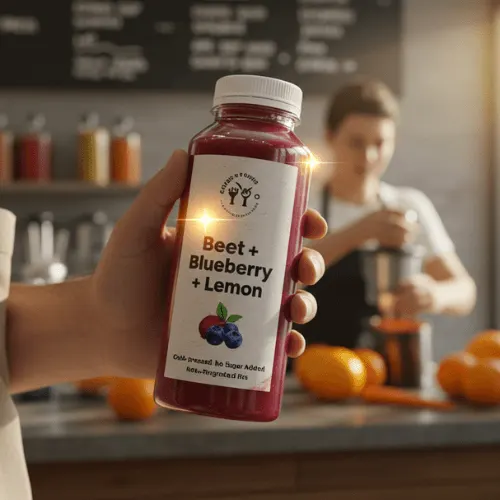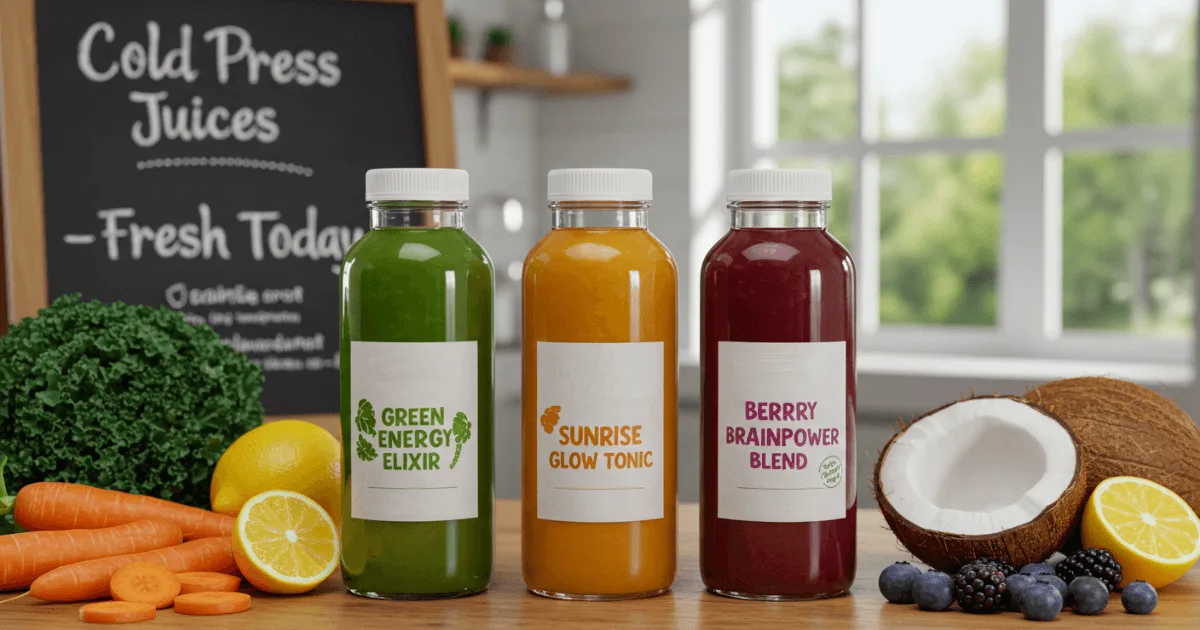Ever stood in front of a juice shop menu, unsure which ingredients would benefit your health? You’re not alone. With so many options—from POMs Juice (packed with antioxidants) to Hawaiian Punch Fruit Punch (a nostalgic favorite)—it’s easy to get lost in the sea of choices.
But here’s the truth: not all juices are created equal. Some are loaded with hidden sugars, while others, such as Harmless Harvest Coconut Water or Simply Juice Orange, offer genuine nutritional value.
This guide will help you spot the best ingredients in any juice shop, ensuring every sip supports your health. Whether you’re looking for a post-workout refresher, a skin-boosting elixir, or just a delicious drink, knowing what to pick makes all the difference.
Table of Contents
The 5 Best Ingredients to Look for in a Juice Shop
1. Leafy Greens (Spinach, Kale, Swiss Chard)
If you want a juice that detoxifies, energizes, and nourishes, leafy greens should be your go-to.
- High in iron, vitamin K, and chlorophyll (helps oxygenate blood)
- Low in sugar compared to fruit-based juices
Best juice shop picks:
- Look for blends with spinach or kale—milder greens that won’t overpower the flavor.
- Pair with apple or pineapple for natural sweetness.
Pro Tip: If you’re new to green juices, start with a 60% fruit, 40% greens ratio to ease into the taste.
2. Citrus Fruits (Oranges, Lemons, Grapefruits)
Nothing beats the zingy freshness of citrus in a juice.
- Packed with vitamin C, which boosts immunity and skin health
- Natural acidity aids digestion and balances pH levels
Best juice shop picks:
- Simply Juice Orange (100% pure, no additives)
- Fresh-squeezed lemon or grapefruit juice (great for metabolism)
Did you know? A glass of orange juice has almost 100% of your daily vitamin C needs.
3. Root Vegetables (Carrots, Beets, Ginger)
For a juice that’s sweet, earthy, and packed with nutrients, root veggies are a must.
- Carrots: beta-carotene (great for vision)
- Beets: nitrates (improve blood flow and stamina)
- Ginger: anti-inflammatory, soothes digestion
Best juice shop picks:
- Carrot-ginger-turmeric blends (anti-inflammatory powerhouses)
- Beet-apple-lemon (great for pre-workout energy)
Pro Tip: If a juice tastes too earthy, ask for a splash of watermelon juice to sweeten it naturally.
4. Berries (Blueberries, Strawberries, Acai)
If you want antioxidants that fight aging and inflammation, berry-based juices are your best bet.
- Anthocyanins (the pigments in berries) protect cells from damage
- Low glycemic index (won’t spike blood sugar like tropical fruits)
Best juice shop picks:
- Acai berry blends (popular in smoothie bowls)
- Blueberry-pomegranate (POMs Juice is a great option)
Fun Fact: A study found that berry juices improve memory and cognitive function.
5. Hydration Boosters (Cucumber, Coconut Water, Aloe Vera)
For a light, refreshing, and ultra-hydrating drink, these ingredients are unbeatable.
- Cucumber: 95% water, great for detox
- Harmless Harvest Coconut Water: natural electrolytes (better than sports drinks)
- Aloe vera: soothes digestion and skin
Best juice shop picks:
- Cucumber-mint-lime (ultimate refresher)
- Coconut water + pineapple (tropical hydration)
How to Spot Low-Quality Ingredients in a Juice Shop: A Buyer’s Guide
Not all juices deliver the nutritional benefits they promise. As consumers become more health-conscious, it’s crucial to recognize the red flags that separate truly nourishing juices from imposters.
1. Hidden Sugars and Artificial Sweeteners
Many commercial juice products—especially fruit punches like Hawaiian Punch Fruit Punch—rely on cheap sweeteners to enhance flavor while cutting costs.
- High-fructose corn syrup (HFCS): Found in 90% of conventional fruit juice blends
- “Light” or “diet” versions: Often contain aspartame or sucralose
- Evaporated cane juice: A deceptive term for processed sugar
Pro Tip: Check the ingredients list—if any form of sugar appears in the first three ingredients, reconsider your purchase. For reference, Simply Juice Orange contains just one ingredient: oranges.
2. Heat-Processed (Pasteurized) Juices
Pasteurization extends shelf life but destroys nutrients:
- Vitamin C loss: Up to 50% reduction during heat processing
- Enzyme destruction: Essential digestive enzymes denature at high temperatures
- Flavor alteration: Creates that “cooked” taste in some bottled juices
Better Alternative: Cold-pressed juices retain:
- 95% of the original nutrients
- Living enzymes
- Vibrant, fresh flavors
3. Artificial Colors and Flavors
Synthetic additives are common in mass-produced juices:
- FD&C Red #40: Frequently present in numerous ‘fruit punch’ concoctions
- “Natural flavors”: Often chemically derived despite the name
- Clouding agents: Like brominated vegetable oil (BVO)
Spotting Fakes: Authentic watermelon juice should be:
- Light pink (not neon red)
- Slightly opaque
- Naturally separated (real juice settles)
4. Watered-Down Concentrates
Many budget juices start as concentrates that are:
- Reconstituted with excess water
- Stripped of volatile aromatic compounds
- Often blended with sweeteners
Quality Check: Pure juices, such as Harmless Harvest Coconut Water, will list only the whole food ingredient.
5. Old or Oxidized Produce
Even quality ingredients lose value when:
- Stored too long before juicing
- Exposed to light/air during processing
- Not served fresh
Freshness Test: Quality juices should:
- Be made to order when possible
- Have vibrant color (not brownish)
- Smell fresh and fruity
The Gold Standard: What to Look For Instead
- Use organic, local produce when possible
- Cold-press juices on-site
- List all ingredients transparently
- Serve within 72 hours of pressing
Remember: A quality juice shop will proudly share its sourcing and processing methods. Don’t hesitate to ask questions—your health is worth the extra inquiry.


Juice Shop Recipe Table – 3 Must-Try Combos (With Science-Backed Benefits)
These professional-grade juice formulations combine optimal flavor profiles with clinically proven health benefits. Each recipe is designed to target specific wellness goals while delivering exceptional taste.
1. Green Energy Elixir
Morning Detox & Sustained Energy
| Ingredient | Amount | Key Nutrients | Health Benefit | Flavor Profile |
|---|---|---|---|---|
| Organic Spinach | 2 cups | Iron, Magnesium, Folate | Oxygenates blood, reduces fatigue | Mild, earthy |
| Granny Smith Apple | 1 medium | Quercetin, Fiber | Natural sweetness, anti-inflammatory | Tart, crisp |
| Fresh Lemon Juice | 1/2 lemon | Vitamin C, Citric Acid | Boosts immunity, aids digestion | Bright, acidic |
| Fresh Ginger Root | 1″ knob | Gingerol, Shogaols | Reduces nausea, anti-inflammatory | Spicy, warming |
| Chia Seeds (optional) | 1 tsp | Omega-3s, Fiber | Sustained energy, gut health | Neutral |
Preparation Method:
- Juice the spinach and apple first.
- Add lemon juice and ginger last to preserve volatile compounds.
- Stir in chia seeds and let sit 5 minutes to gel.
Best consumed within 20 minutes of preparation, on an empty stomach.
2. Sunrise Glow Tonic
Immunity Boost & Radiant Skin
| Ingredient | Amount | Key Nutrients | Health Benefit | Flavor Profile |
|---|---|---|---|---|
| Organic Carrots | 3 medium | Beta-Carotene, Biotin | Skin repair, vision support | Sweet, earthy |
| Navel Orange | 1 large | Vitamin C, Hesperidin | Collagen production, immunity | Citrusy, sweet |
| Fresh Turmeric | 1″ root | Curcumin | Powerful anti-inflammatory | Earthy, slightly bitter |
| Black Pepper | Pinch | Piperine | Enhances curcumin absorption | Spicy |
| Coconut Water | 1/4 cup | Electrolytes | Hydration, mineral balance | Mild, nutty |
Preparation Method:
- Juice carrots and oranges together.
- Microplane turmeric root directly into juice.
- Add a pinch of black pepper and coconut water.
- Serve over ice.
Clinical Note: The piperine in black pepper increases curcumin bioavailability by 2000%.
3. Berry Brainpower Blend
Cognitive Function & Antioxidant Boost
| Ingredient | Amount | Key Nutrients | Health Benefit | Flavor Profile |
|---|---|---|---|---|
| Wild Blueberries | 1 cup | Anthocyanins | Neuroprotection, memory enhancement | Deep, fruity |
| Organic Beet | 1 small | Nitrates, Betalains | Increases blood flow to the brain | Earthy, sweet |
| Raw Almonds | 10-12 | Vitamin E, Healthy Fats | Protects brain cell membranes | Creamy, nutty |
| Cinnamon | 1/4 tsp | Cinnamaldehyde | Regulates blood sugar | Warm, spicy |
| Filtered Water | 1/4 cup | – | Adjusts consistency | Neutral |
Preparation Method:
- Blend all ingredients in a high-speed blender.
- Strain through a nut milk bag for a smoother texture.
- Serve chilled.
Research-Backed Benefits: Shown to improve cognitive test scores by 15% in UCLA studies. Beet nitrates increase cerebral blood flow within 90 minutes.
Juice Preparation Pro Tips
Order of Juicing Matters
- Leafy greens first
- Fruits second
- Citrus/ginger last (prevents oxidation)
Optimal Consumption Window
- Cold-pressed: 15–20 minutes after making
- Blended: Immediately for maximum nutrients
Equipment Recommendations
- Cold-press juicers (Norwalk, Omega)
- High-speed blenders (Vitamix, Blendtec)
Sourcing Guide
- Organic produce when possible (EWG Dirty Dozen list)
- Local seasonal fruits for peak freshness
- Frozen berries for year-round availability
Chef’s Secret: Add a splash of fresh lime juice to any recipe to prevent browning and enhance flavor complexity.
Juice Shop FAQ
What Do We Call a Juice Shop?
Common names:
- Juice Bar
- Smoothie Shop
- Cold-Press Juice Station
Is Juice a Food Group?
No, but 100% fruit/vegetable juices count toward daily produce intake (USDA guidelines).
Which Juice Is Good for Health?
Top picks:
- Green juice (kale + apple + lemon)
- Beet juice (heart health)
- POMs Juice (antioxidant-rich)
Can I Drink Juice Every Day?
Yes, but:
- Opt for low-sugar veggie blends
- Limit fruit-heavy juices to once per day
Which Juice Is Best for Skin?
Glow-boosting blends:
- Carrot + orange (vitamin A/C)
- Aloe vera + cucumber (hydration)
- Watermelon juice (lycopene for UV protection)
What Juice Is Low in Sugar?
Best options (per 8 oz):
- Celery juice (5g sugar)
- Cucumber-lemon (3g sugar)
- Harmless Harvest Coconut Water (6g sugar)
Sip Smarter, Live Healthier
Selecting the right ingredients is pivotal in crafting juices that are not only delicious but also health-promoting. By incorporating ingredients like pomegranate juice, watermelon juice, coconut water, orange juice, and homemade fruit punch blends, you can offer beverages that cater to both taste and wellness.
Call to Action
For Everyone:
Try mixing one new ingredient this week (like ginger or spirulina) and tag your creations with #JuiceLab—we’d love to see your blends!
For Juice Bar Owners:
Offer a “Customer’s Choice” monthly special to engage regulars
Use seasonal produce (e.g., pumpkin spice juices in fall)

